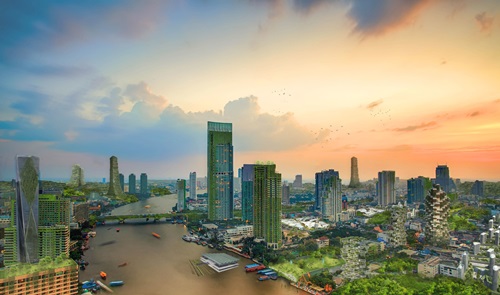FutureTales Lab by MQDC Reveals 4 Scenarios for Developing Bangkok's Future
3 พ.ย. 63 10:26 น. /
ดู 19,508 ครั้ง /
0 ความเห็น /
0 ชอบจัง
/
แชร์

3 November 2020, Bangkok Bangkok's location leaves it liable to floods that affect more and more of us each rainy season and raise questions about its future. Will the city stay above water and how else might it change?
Dr. Karndee Leopairote, Chief Advisor to FutureTales Lab by MQDC, said: "FutureTales Lab by MQDC has researched urban living trends and Bangkok's development. How will the city change? And what will people's lifestyles be like? Using a global urban development planner and a team of urban developers under MQDC, we have examined the city's vulnerability to rapid climate change and the potential impacts. To see how a city like Bangkok could adjust we have explored 4 scenarios:
1. Green Metropolis: Bangkok can be developed into a green city if there is serious legislative action and change in urban lifestyles that turns skyscrapers into well-designed green buildings. Efficient energy use and environmental conservation can help create and setting that supports physical and mental health in the metropolis. More green space can sustainably improve air quality.
2. River City: When the water level rises in a city and the ground inevitably sinks, its residents must learn to adapt to live with increased water. Innovation is needed to live on the surface of the water and develop a city that needs less land. Sustainable development of homes that coexist with water, such as floating markets, can create a network that meets the needs of people. The response to living on rivers includes floating solar farms whose panels turn solar energy into electricity.
3. Indoor City: Living conditions could collapse under an undesirable scenario if rising global temperatures and air pollution make it hard to stay outdoors. A failure to adapt our lifestyles and implement effective urban policy could bring this to reality. When the city is dusty and hot, for example, people turn on their air-conditioning and stay inside. If indoor air is chilly, they shelter under a blanket rather than adjusting the thermostat. The city could adjust to toxic outdoor conditions with covered walkways between buildings that protect from air pollution. The situation could bring extreme inequality in areas like access to clean air, which should be a fundamental right of all living beings, not just humans.
4. Disaster-Resilient City: The best outcome for the city is urban development that incorporates disaster response. Thailand experienced 213 floods in the 20 years from 1989 to 2009. In 2011, more than 69.02 million rai of land was flooded through various disasters. The city must therefore develop infrastructure to cope with unforeseeable events. Green areas can be developed to store water in the rainy season. All forms of life should also be adapted to cope with floods or droughts. Water catchments areas can store water for use by the city or nearby communities. Public spaces can be created that cater for leisure and expand urban green space while providing a rescue point and space for people in a disaster.
"We believe that our lifestyles and behaviors today, along with government strategy, will affect the future in terms of living, technology, transportation, and healthcare, showing that we need to prepare in various dimensions and act appropriately and efficiently to live sustainably in a society that changes in the future," said Dr. Karndee.
Reference:
https://www.thaiwater.net/web/index.php/flood-history.html
https://thaipublica.org/wp-content/.........??ไทย.pdf
1. Green Metropolis: Bangkok can be developed into a green city if there is serious legislative action and change in urban lifestyles that turns skyscrapers into well-designed green buildings. Efficient energy use and environmental conservation can help create and setting that supports physical and mental health in the metropolis. More green space can sustainably improve air quality.
2. River City: When the water level rises in a city and the ground inevitably sinks, its residents must learn to adapt to live with increased water. Innovation is needed to live on the surface of the water and develop a city that needs less land. Sustainable development of homes that coexist with water, such as floating markets, can create a network that meets the needs of people. The response to living on rivers includes floating solar farms whose panels turn solar energy into electricity.
3. Indoor City: Living conditions could collapse under an undesirable scenario if rising global temperatures and air pollution make it hard to stay outdoors. A failure to adapt our lifestyles and implement effective urban policy could bring this to reality. When the city is dusty and hot, for example, people turn on their air-conditioning and stay inside. If indoor air is chilly, they shelter under a blanket rather than adjusting the thermostat. The city could adjust to toxic outdoor conditions with covered walkways between buildings that protect from air pollution. The situation could bring extreme inequality in areas like access to clean air, which should be a fundamental right of all living beings, not just humans.
4. Disaster-Resilient City: The best outcome for the city is urban development that incorporates disaster response. Thailand experienced 213 floods in the 20 years from 1989 to 2009. In 2011, more than 69.02 million rai of land was flooded through various disasters. The city must therefore develop infrastructure to cope with unforeseeable events. Green areas can be developed to store water in the rainy season. All forms of life should also be adapted to cope with floods or droughts. Water catchments areas can store water for use by the city or nearby communities. Public spaces can be created that cater for leisure and expand urban green space while providing a rescue point and space for people in a disaster.
"We believe that our lifestyles and behaviors today, along with government strategy, will affect the future in terms of living, technology, transportation, and healthcare, showing that we need to prepare in various dimensions and act appropriately and efficiently to live sustainably in a society that changes in the future," said Dr. Karndee.
Reference:
https://www.thaiwater.net/web/index.php/flood-history.html
https://thaipublica.org/wp-content/.........??ไทย.pdf
เลขไอพี : ไม่แสดง
| ตั้งกระทู้โดย Windows 7
อ่านต่อ คุณอาจจะสนใจเนื้อหาเหล่านี้ (ความคิดเห็นกระทู้ อยู่ด้านล่าง)
ความคิดเห็น
ยังไม่มีความคิดเห็น
จะต้องเป็นสมาชิกจึงจะแสดงความคิดเห็นได้
เป็นสมาชิกอยู่แล้ว ลงชื่อเข้าใช้ระบบ
ยังไม่ได้เป็นสมาชิก สมัครสมาชิกใหม่
หรือจะลงชื่อเข้าใช้ระบบด้วย Google หรือ Facebook ก็ได้
ลงชื่อเข้าใช้ระบบด้วย Facebook
ลงชื่อเข้าใช้ระบบด้วย Google
เป็นสมาชิกอยู่แล้ว ลงชื่อเข้าใช้ระบบ
ยังไม่ได้เป็นสมาชิก สมัครสมาชิกใหม่
หรือจะลงชื่อเข้าใช้ระบบด้วย Google หรือ Facebook ก็ได้
ลงชื่อเข้าใช้ระบบด้วย Facebook
ลงชื่อเข้าใช้ระบบด้วย Google

